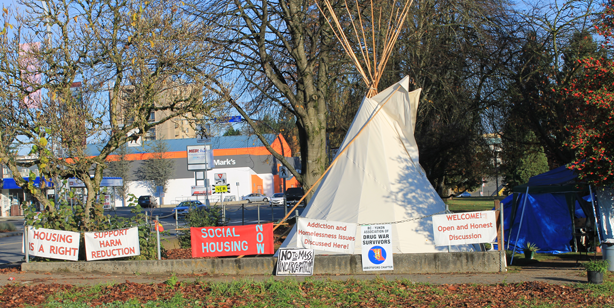By Katherine Gibson (The Cascade) – Email
Print Edition: April 2, 2014

Unless you’ve been living under a rock for the past year, you know homelessness is a hot-button issue in Abbotsford. True to form, the City’s announcement on March 20 of a new “task force on homelessness” has brought with it expected controversy.
The task force, which is made up of individuals representing organizations such as B.C. Housing, faith-based organizations, as well as the Abbotsford Police Department and Abbotsford’s Chamber of Commerce, will look to create solutions that address homelessness within the city.
As Mayor Bruce Banman explains, this task force was put together with the intention of placing key “decision makers” in the same room, in order to come up with practical solutions.
“There has been extensive thought put into this to bring decision makers to the table,” Banman says. “Everybody around that table all has one unified goal and that is to come up with solutions.”
However, noticeably missing from the task force are agencies like 5 and 2 Ministries that play an active role in working with the homeless populations in Abbotsford on a daily basis.
Although Abbotsford Community Services (ACS) is represented through Food Bank representative Dave Murray, the leading figures with knowledge of Abbotsford’s homeless issue at ACS, such as executive director Rod Santiago, were never approached to sit on the board.
The lack of these agencies’ presence is of great concern to the executive director of 5 and 2 Ministries, Ward Draper, who says that without these “front-line” agencies the City’s task force risks misrepresenting or misunderstanding the issue.
“Our greatest concern with this homelessness task force [is that] the four major primary agencies that deal with these [homeless] community issues are not represented,” Draper says. “The ones that are literally on the front lines daily: Cyrus centre, [which deals with] youth homelessness; The Warm Zone, [which helps] the women on the street; the Salvation Army; [and] the 5 and 2 [Ministries] — the four key agencies that keep people alive every day on the streets are not even represented.”
ACS community relations representative Jana Dieleman echoes Draper’s concerns, questioning why members of commerce are on the task force, while people and agencies who are “the boots on the ground” are absent.
In response to these concerns, Banman says these agencies will still have their input and voices heard, despite not sitting directly on board.
“It was deemed by those who were putting [the task force] together that if we want to get results, this was the committee we needed to have,” Banman says. “There will be extensive consultation done by the committee members with service providers, such as the Salvation Army [and] 5 and 2 [Ministries] — there will be an opportunity for that to happen.”
Banman further noted that the City is still in talks with B.C. Housing to keep the $2.6 million that was intended for the ACS proposed supportive housing project, but voted down by the council due to rezoning, in order to help address the issue.
Although the task force, which has not officially met yet, intends to come up with solutions for Abbotsford’s homeless population, Draper asserts that the citizens will need to keep them accountable by pushing for more inclusive representation of those actively involved in the homeless issue.
“I would encourage students … to get on [the city’s] case and make this a true task force, something that will have legs,” Draper says. “Task forces have proven effective and they have been constructive … but that’s when the full spectrum is represented and not just a group of elites that have read a couple of documents.”
